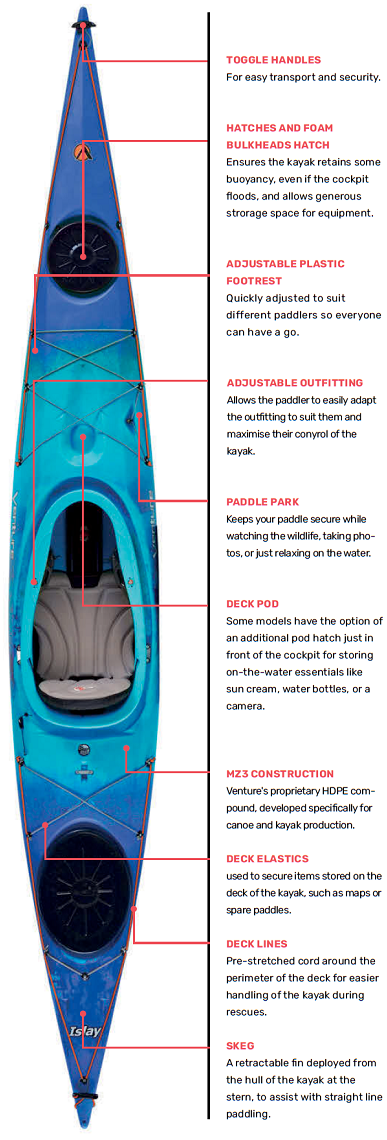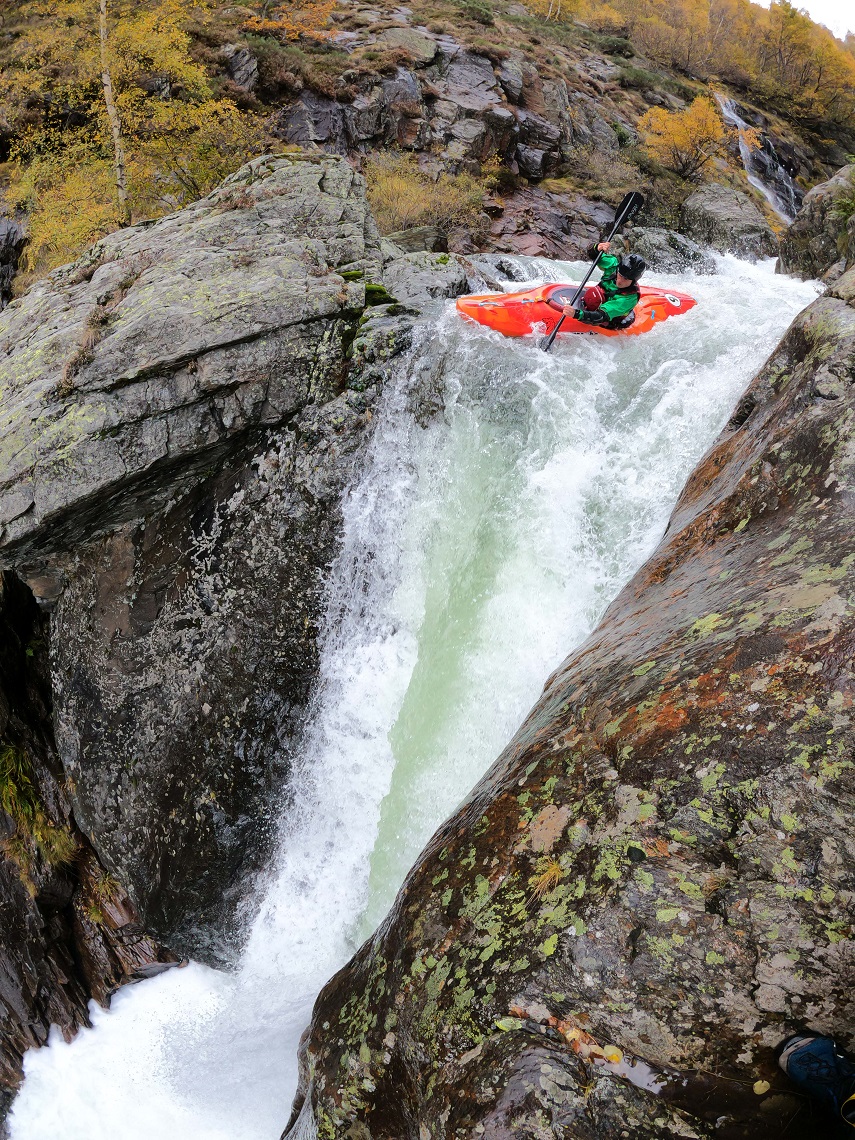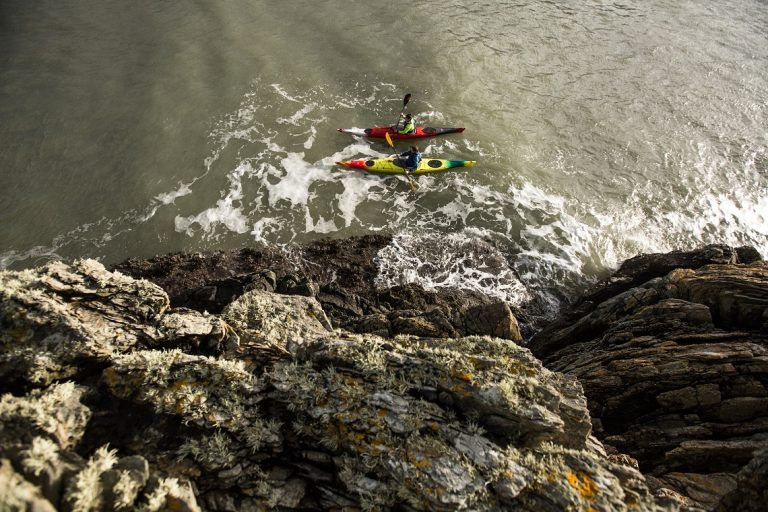WATER WAYS
PADDLE SPORTS are the perfect, ECO-FRIENDLY way to explore wilder areas of the UK and beyond — but how do you get started? We catch up with MAT WILKINSON of VENTURE KAYAKS, to get the LOWDOWN on boats for BEGINNERS
Canoe or kayak — what are the main differences?
Most usually, a canoe is open-topped and paddled with a single-sided paddle, while a kayak is something you sit inside and paddle with a double-sided paddle; the biggest exceptions are sit-on-top and inflatable kayaks, which tend to be open-topped, but are paddled with a double-sided paddle.
How will I know which is right for me?
It really depends on what adventures you have in mind, how much gear you have, and how many paddlers are coming along. The Venture Ranger 162 open canoe is great for family adventures, while the Pyranha Fusion II kayak is the better choice for individuals who want the flexibility to enjoy a variety of water-based adventures, from moderate whitewater to touring. The best way to figure out what’s right for you is to head to your local specialist canoe and kayak shop and talk to their knowledgeable staff, then try out a few options.
What’s the best way to get into paddle sports?
Booking on to an intro course at a centre or with a professional coach is a great way to shortcut the initial challenges. Or you might want to head out on a guided trip to give the sport a go. In these situations, you’re often provided with a boat and equipment as part of the package.
Another option is to join a canoe club and take part in their pool sessions or group trips. Clubs often have equipment and boats that can be used by members; depending on the club, you may find a wider range of boats to try in these situations, although you’ll sometimes find they’re a little older and more ‘well-loved’ than the fleets found at centres or other professional outfits. Many clubs will also focus on a specific discipline, whether it be whitewater, slalom, racing, canoe polo, or sea kayaking, so it’s important to find one that focuses on what you want to do.
If you’re not keen on a group setting or would rather figure things out for yourself, you can head to your local specialist canoe and kayak shop and get some expert advice on what boat and kit you’ll need for your ambitions. Whether you want to experience the adrenaline rush of whitewater, or just unwind and take in the scenery on calm water, there’s often the opportunity to try before you buy. After that point, there is a wealth of tutorials on YouTube, and Facebook groups where you can seek advice from your peers or those with a little more experience.

I want to go paddling with the whole family — what are my options?
A canoe is a great option here, especially for families with young children, as you’ll all be in the same boat (literally!). In a similar vein, you could look at tandem kayaks (sit-on or sit-inside), or if everyone is old enough to handle a boat themselves then go for one each!
Is there a lower age limit for paddle sports?
You can pretty much get the kids on the water as soon as there’s a good-fitting buoyancy aid available for them (around 18 months), but of course, the younger the children with you, the more precautions you should take, such as sticking close to shore, only paddling in calm and warm conditions, and making sure you’re somewhere well within your abilities where you can control the boat and keep a close eye on the little one at the same time.
What’s the bare minimum of equipment you need to try paddle sports for the first time?
You don’t need a whole lot; suitable clothing for the weather and water conditions, a buoyancy aid with a reliable means of calling for help kept in one of its pockets, and of course, a boat and a paddle — much of this will be provided for you if you’re headed to a centre, club, hirer, or guided trip.
What are the best things to wear while paddling?
On your feet, you’ll want a quick-draining pair of shoes with a decent sole that you don’t mind getting smelly. To keep you warm, synthetic thermal base layers are great as they absorb less water, or you can go for neoprene shorts or a long john wetsuit if you prefer. A waterproof top with a good seal around the wrists will help you keep the wind and splashes at bay, and on top of that, you should wear a well-fitted buoyancy aid.
I’ve done a bit of paddling before, and I’m ready to go it alone — what am I looking for in a beginner’s kayak or canoe?
It’s rarely a good idea to go paddling alone, but if you do, you should carry a reliable means of communication on your person, ideally in a waterproof pouch that’s tethered into one of your buoyancy aid pockets. Make sure to tell someone where you’re going and when to expect you back, too.
In terms of the boat, it should be well-sized for you (not too big to control, but also not too small, so you stay stable and afloat), and in most situations, it’s advisable to have some sort of internal buoyancy, whether that’s airbags in a whitewater kayak or open canoe, or bulkheaded bow and stern hatches in a sea kayak.
What should I expect to pay for a beginner’s boat?
Our kayaks start at around £750; there are cheaper boats out there, but you’re usually compromising in performance, safety, durability, or all three.
Are there any things I should avoid or be aware of when making my purchase?
The main pitfalls are found in the second-hand market; beware of buying old kayaks (over 12 years of age) where the plastic may have become brittle, or which may have missing or broken parts that are no longer available. Other things to look out for are scratches deeper than a millimetre or two, wobbles in the hull, discolouration of the plastic, and loose or deteriorating internal fittings; all of these are signs of a boat past its prime.
If you’re buying new from a specialist canoe and kayak shop, you can be sure that what you’re buying will be fit for purpose and backed by a manufacturer’s warranty and aftersales service from the shop itself.
What’s ‘outfitting’?
‘Outfitting’ is just a fancy word for the internal fittings of the kayak, including the seat, footrests, thigh grips, and backrest.
Where are the best beginner’s spots in the UK to take my new boat?
We’re lucky to have an excellent selection of places to paddle in the UK, including myriad bodies of water in the Lake District, Wales, and Scotland, an extensive network of canals and rivers throughout the UK, and of course, stunning coastlines all around our isles. The best place to find out about water-based adventures in your local area is, you guessed it, your local specialist canoe and kayak shop!
Are there any places I should be wary of or avoid taking my boat?
Stay away from weirs, fast-flowing rivers, unfamiliar currents or tides, or anywhere where access is restricted (such as reservoirs, or anywhere you’d have to trespass on other people’s land to get to or from the water).
Do I need a special license or permit?
A Waterways Licence is required to paddle on some canals and rivers in the UK, and this is most affordable to obtain as part of a British Canoeing membership (members.britishcanoeing.org.uk).

How do I transport my boat safely — and how do I store it?
The best way to transport a canoe is upside down on a good quality, padded roof rack; for a kayak, you can either do the same (avoiding resting the cockpit or hatch rims against the bars) or add a set of J-bars or uprights to secure the kayak against on edge. Storage is a similar case of ensuring the boat is properly supported on a padded rack, as well as keeping it out of direct sunshine and away from frost and critters, somewhere where the inside can dry, leaving off any hatch covers to allow it to do so.
How do I maintain my boat and kit?
Apart from proper transport and storage, you can prolong the life of your canoe or kayak through appropriate usage (avoid dragging the boat, or abrasions or collisions with hard surfaces when paddling, for example), regularly rinsing the boat with fresh water, and periodically checking it over for any loose or broken components, particularly those with a mechanical element, and repairing or replacing as necessary.
What’s your advice to anybody thinking of getting into paddling?
Do it!! A life of paddling started as a one-off session for me, but after a scattering of additional ‘one-offs’ I realised I was hooked, and now I can’t think of a better way to get away from it all, find peace and quiet, and explore the outdoors from a different perspective.
To start your own paddle-powered adventure, see www.venturekayaks.com.



